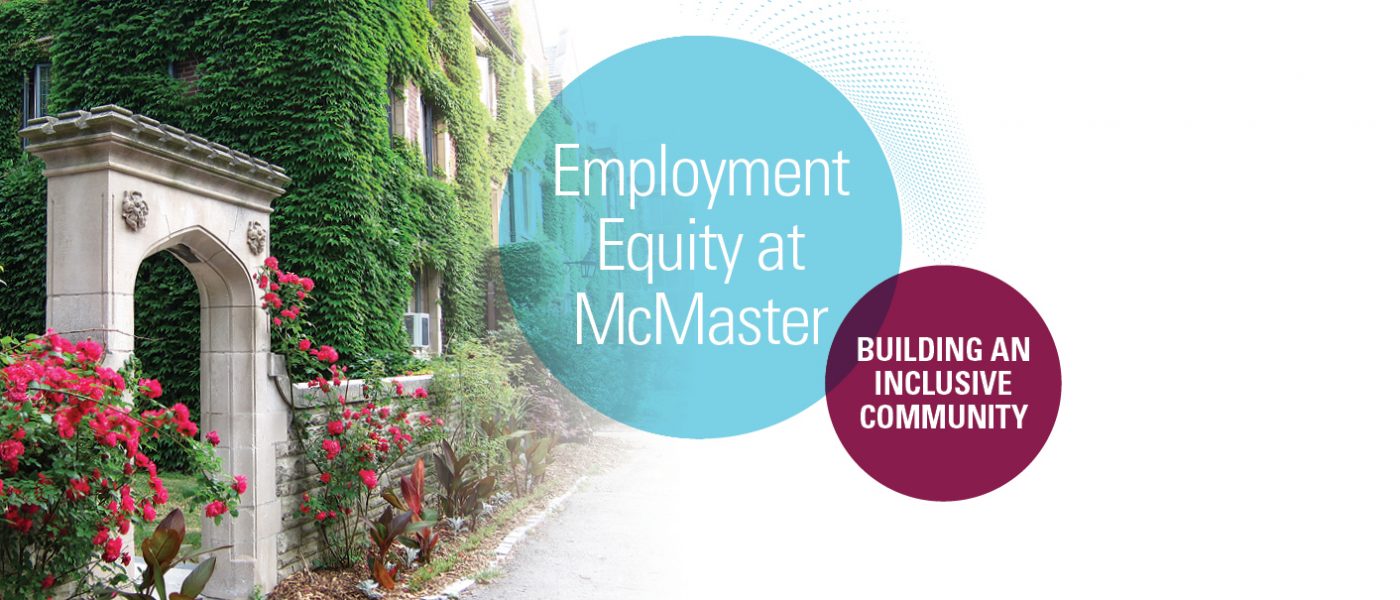Frequently Asked Questions
Expandable List
There are many definitions of diversity. For McMaster University, diversity encompasses race, religious belief, indigeneity, colour, gender, physical disability, mental disability, marital status, ancestry, age, place of origin, family status, sexual orientation, and gender identification, as well as other characteristics that shape an individual’s attitudes, behaviours and perspectives. It is at the core of our innovation and creativity, and strengthens our research and teaching excellence.
Employment equity focuses on eliminating barriers to the employment of the federally designated groups: First Nations, Métis, and/or Inuit peoples, racialized persons, persons with disabilities, and women. McMaster has expanded its commitment to include trans persons and other members of the 2SLGBTQIA+ community.
As a process, employment equity aims to identify and eliminate discrimination in employment procedures and policies, remedy the effects of past discrimination, and ensure appropriate representation of the designated groups throughout a workforce. It is compatible with the concept of diversity; both aim to achieve and value a workforce that reflects the diverse composition of the broader community.
Employment equity is not simply an element of McMaster’s strategic plan. It is essential for building our greatest strength: the people who work every day to discover, communicate and preserve knowledge, to support our students and researchers, and to ensure the successful functioning of our University.
There are currently four groups selected as the focus of employment equity because their labour market experience reveals long-standing patterns of high rates of unemployment and under-employment, and concentration in low-pay and low-status jobs. The federally designated groups are First Nations, Métis, and/or Inuit peoples, racialized persons, persons with disabilities, and women. McMaster has expanded its commitment beyond the four designated groups, to include trans persons and other members of the 2SLGBTQIA+ community.
No. Employment equity plans aim to change the workforce composition so that it reflects the community. Reverse discrimination occurs when a less-qualified candidate is hired. “Reverse discrimination” implies that First Nations, Métis, and Inuit peoples, racialized persons, persons with disabilities, women, trans persons and others members of the 2SLGBTQIA+ community are less likely to be the right job candidates than non-First Nations, Métis, and Inuit, white, non-disabled, male, cis-gendered, straight candidates. Research from a range of sources consistently shows that it is members from the federally designated groups who face discrimination, get less access to educational programs and training, and are more frequently denied jobs and promotions when they have relevant qualifications and experience.
McMaster University continues to hire the best-qualified candidates, and employment decisions continue to be based on job performance criteria, such as skills, knowledge, and abilities. To ensure that we attract the best available candidates, efforts are made to enlarge the pool of qualified applicants from which candidates are selected. This involves advertising job vacancies more widely, encouraging applications from members of the federally designated groups and 2SLGBTQIA+ candidates, and ensuring that recruitment and selection processes are bias-free.
No. Employment equity is not an exclusive process, but rather an inclusive one. It does not impose barriers on, or deny employment opportunities to, people who are not from designated groups. Instead, all applicants compete against an expanding group of candidates when applying for jobs or promotions, because employment equity seeks to give everyone an equitable opportunity to compete for jobs. Neither the federal government nor the University imposes quotas for hiring members from the federally designated groups or 2SLGBTQIA+ persons.
McMaster’s Employment Equity program attempts to:
- Collect, analyze and report on workforce data to track progress in achieving representation of Designated Group members in accordance with the University’s Employment Equity Policy;
- Provide employees with training in the meaning and application of Employment Equity;
- Address and mitigate systemic discrimination by identifying and removing barriers in employment policies, practices and procedures;
- Achieve representation, where Designated Groups are under-represented, through specific recommendations for action to be undertaken by senior administrators, Special Measures, and Accommodations to enable members of Designated Groups to compete on an equitable basis for employment opportunities;
- Pursue other initiatives to address ongoing systemic and structural gaps as identified by the University Administration (for example, develop employment equity resources, guidelines for hiring).
No. Employment equity is about hiring the best person for the job by ensuring that applicants are not ruled out by systemic barriers. It attempts to include members from the designated groups in the applicant pool so that everyone has an equitable chance for employment and/or promotion. Employment equity means hiring and promoting people based on their skills and abilities to do a job. McMaster University continues to hire the best-qualified candidates, and employment decisions are based on job performance criteria, such as skills, knowledge, and abilities. Employment equity requires that we remove barriers and overcome both direct and indirect discrimination. In this way, the pool of excellent candidates increases substantially.
Our employment equity initiatives include a systematic review of employment policies and practices. Changes are made so that all current and prospective employees of equal qualification have equitable access to training, retraining, job assignments, transfers, and promotions.
Employees are also encouraged to keep their employment equity census information up to date. This assists with institutional planning and evaluation of programming efforts.
At McMaster University, all new employees are asked to complete the Employment Equity Census, in which they are invited to self-identity within any of the equity-deserving groups. Completion of the census is voluntary and individual responses are kept confidential and reported in aggregate, anonymized form only, unless otherwise stated. The resulting information helps Human Resources get a clearer picture of who is employed in the workplace and how the University is doing in its progress toward equity, inclusion and belonging.
Current employees can update their Employment Equity Census information at any time.
Job applicants are also invited to complete an Applicant Diversity Survey as part of their application in Mosaic. As with new and current employees, individual responses remains confidential and is not shared with hiring managers or supervisors, unless otherwise stated.
All personal information collected in handled in compliance with the McMaster University Notice of Collection, Use and Disclosure Statement and the Freedom of Information and Protection of Privacy Act of Ontario (FIPPA).
Further, collecting employment equity information ensures our researchers have the opportunity to bid on and receive research contracts with the Government of Canada.
In terms of building an inclusive environment that supports employment equity, everyone has a role to play. Training is available for all McMaster employees, including those with unique accountabilities, such as those involved in hiring and other employment processes.
The information you provide in the employment equity census provides information on the composition of the McMaster University workforce. Your answers help the University advance employment equity goals and inclusive excellence priorities.
If you require assistance please contact the Employment Equity team in Human Resources Services at hr.empequity@mcmaster.ca.
No. The data you provide on the census is strictly confidential and presented in anonymized aggregate form only, unless otherwise stated. This information is used for institutional reporting and planning purposes and to develop initiatives to remove barriers to employment for the designated groups.
No. The information is presented in aggregate anonymized from only, unless otherwise stated, to protect the privacy of individuals.
Please refer to the Employment Equity Census – Confidentiality and Privacy Considerations for more details on how your information is protected.
Yes. Where appropriate, employees may identify themselves as belonging to more than one designated group. This is justified by the fact that each designated group faces particular kinds of employment barriers. A person who belongs to more than one of these groups is likely to experience multiple barriers.
McMaster’s employment equity program promotes full opportunity for all faculty and staff. Thus, by completing your census, you help McMaster expand job opportunities for all employees and ensure that McMaster treats all current and prospective employees equitably. Removing barriers opens up new opportunities for all people in the workforce. For example, organizations may find new ways to advertise jobs, so they can reach a wider pool of candidates.
Yes. At any time in the future, you can update the census online in Mosaic.
If you are unable to complete the census online for accessibility reasons, you may submit a completed paper copy to the Employment Equity team in Human Resources Services.
Alternate format is also available on request. Please contact hr.empequity@mcmaster.ca.
Yes. Even if your condition has been accommodated in McMaster’s workplace, you should still answer yes.
No. Disability is not intended to include relatively minor conditions that are experienced by large segments of the population. The determining factor is the severity of the condition and the impact it has on your ability to perform your job.
For the purposes of this survey, gender diversity refers to a person whose gender identity or self-expression differs from conventional expectations of masculinity or femininity. This includes people who self-identify as transgender, non-binary or gender-fluid, gender non-conforming, gender variant, or an analogous term.
While the federal government requires information based on the four designated groups, the University’s also collects data on gender diversity, sexual orientation and religion, as an extension of McMaster’s commitment to equity, diversity, inclusion and belonging. The University collects this information as it can help to develop employment equity strategies that eliminate additional barriers to employment based on these identities. The data collected from these questions is reported in an anonymized aggregate form at an institution-wide level only.
Cant find what you're looking for? Contact us:

Melanie Garaffa
Associate Director, Talent, Equity and Development, Organizational Development


